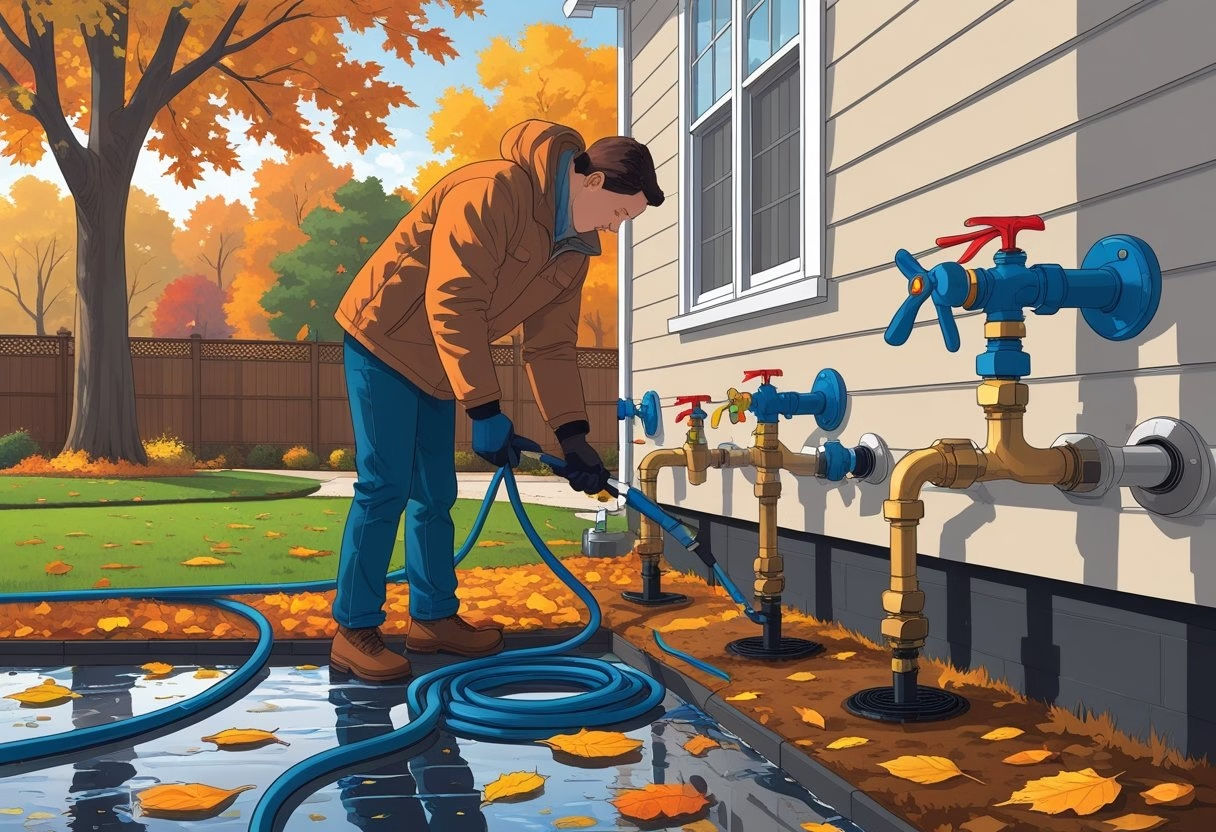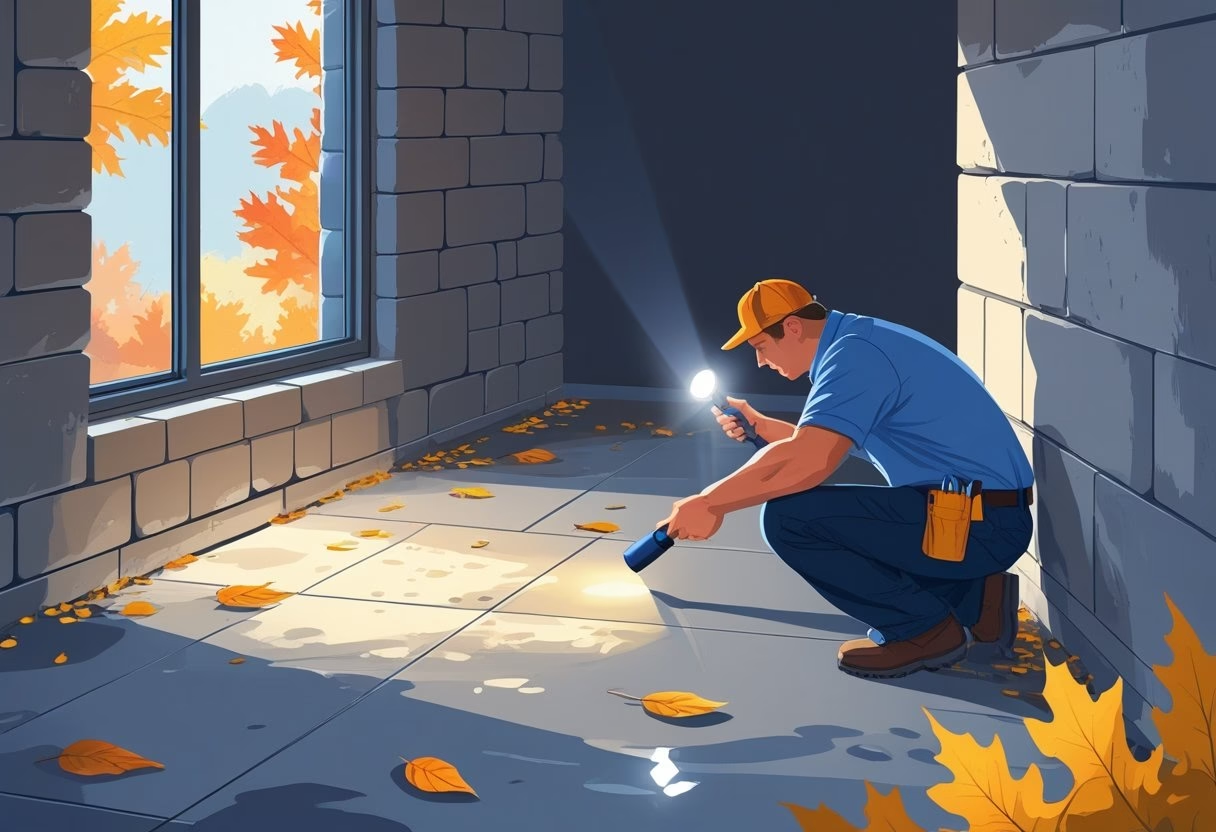Fall feels like the right time to get your house ready for winter’s rough weather. If you handle key repairs now, you’ll probably dodge those pricey emergency calls when the cold sets in and outdoor work gets, well, miserable.
The milder temps in autumn give you a chance to fix things before they spiral. It’s just easier to get stuff done when you’re not freezing or sweating buckets.

Some folks use fall as their “get ready” season, and honestly, it pays off. Roof checks, heating system tune-ups—these little moves can spare you a lot of money and stress when winter hits.
1) Inspect and repair roof shingles
Fall’s the time to eyeball your shingles before winter storms roll in. Scan for missing, cracked, or curled shingles—anything that might let water sneak through.
Walk around outside and look up. Spot any shingles that don’t match the rest or see bare patches where granules have washed away?
Keep an eye out for popped nails or warped shingles. These only get worse with snow and ice.
Peek in the gutters for shingle granules. If you see a lot, your shingles are probably on their last legs.
Swap out a few bad shingles or tack down loose ones with some roofing cement. That’s usually enough for small fixes.
For missing shingles, slide in a replacement and nail it down. Dab some roofing cement under the edges to lock it in.
But if you see big bare spots or a bunch of missing shingles, call a roofer. Some jobs just need the pros.
Estimated difficulty: Moderate for minor fixes; call in a pro for major repairs.
2) Clean and clear gutters and downspouts
Falling leaves love to clog up gutters. When they pile up, water can’t drain right and you end up with all sorts of headaches.
Best to clean gutters after most leaves drop, but before winter storms. Usually, you’ll need to do it twice in the fall.
Scoop out leaves and junk by hand. Then grab a hose and flush out the rest—watch the water flow to spot any clogs.
If downspouts back up, blast them with the hose or poke out the blockage from the top.
Check for sagging spots, loose screws, or leaky joints. Fix these now, before rain or snow makes things worse.
Clogged gutters can cause ice dams and water damage, not to mention issues with your siding and foundation. Nobody wants that.
Clean gutters keep water away from your house and stop mold or structural problems from cropping up.
Use a sturdy ladder and have someone nearby. Gloves help too—those edges get sharp.
Estimated Difficulty: Moderate – a bit physical, but doable for most folks with care.
3) Seal gaps and cracks around windows and doors
Cold air loves to sneak in through tiny gaps near windows and doors. Drafts make your house chilly and your bills bigger.
The Department of Energy says sealing leaks can save you 10% to 20% on energy. Not bad for a little caulk and weatherstripping.
First, clean the frames and scrape off old caulk so new stuff sticks. Don’t rush this part—it matters.
Stick on weatherstripping for windows and doors that move. Foam, V-strip, or felt—pick what fits your frames best.
Squeeze caulk into cracks around frames, using weather-resistant stuff for outside. Smooth the bead with your finger for a neat finish.
Check baseboards near windows and doors—air sneaks in there too. Replace any weatherstripping that looks worn out.
This quick job keeps the drafts away and your wallet a bit happier.
Estimated difficulty: Easy to moderate. Just need some basic tools and a bit of patience.
4) Service and inspect the HVAC system
Your heating system deserves a checkup before winter. Change the air filter—dirty ones make your system work way too hard.
Call an HVAC tech for a tune-up. They’ll check burners, heat exchangers, and clean up parts you probably don’t want to mess with.
Pro service spots little issues before they get expensive. It’s worth the peace of mind.
Test your thermostat—make sure it flips between heat and cool without a hitch.
If you have a heat pump, clear away leaves and junk from the outside unit. Airflow matters.
Pop off the vent covers inside and vacuum out the dust. Move any furniture blocking vents, too.
Estimated difficulty for non-skilled homeowner: Easy to moderate for the basics; hire a pro for anything technical.
5) Check and clean the chimney and fireplace
Get your fireplace ready before you light that first cozy fire. Check the chimney outside for cracks, loose bricks, or a busted cap—water leaks are no joke.
Look inside for soot or weird white stains. Both can mean trouble.
Clear out leaves, nests, or anything else that got in over the summer. These block airflow and could catch fire.
Test the damper—open and close it to make sure it’s not stuck. You don’t want smoke drifting into your living room.
The National Fire Protection Association says get your chimney checked every year. Chimney sweeps clear out dangerous creosote and spot issues you might miss.
Install or replace chimney caps and screens to keep critters and debris out. It’s a simple fix that saves headaches.
Double-check your smoke and carbon monoxide detectors before using the fireplace. Safety first, right?
Estimated Difficulty: Moderate to high. For most, it’s smart to call a pro.
6) Add or upgrade attic insulation
If your attic’s under-insulated, heat just floats away in winter. That means your furnace works overtime and your bills go up.
Adding insulation can knock 20% off your heating costs. That’s not pocket change, especially over a cold season.
Check how much insulation you’ve got. Most attics need at least 10 to 14 inches for real protection.
Fiberglass batts are cheap and easy. They come in rolls that fit between the joists.
Blown-in insulation fills weird gaps better. It’s great if your attic’s not a perfect rectangle.
Fall’s a good time to tackle this—attics aren’t freezing or boiling.
Seal up gaps around pipes and electrical boxes before you add insulation. Those little holes leak a lot of heat.
Most folks can do this themselves with the right safety gear. Just be careful and take your time.
Estimated difficulty: Moderate.
7) Test and replace smoke and carbon monoxide detectors
With more time indoors and heaters running, fire and carbon monoxide risks go up in fall. It’s the right time to check those detectors.
Press the test button on each detector until you hear the alarm. If it’s quiet, swap the batteries and try again.
If it still doesn’t work, replace the whole unit. Most only last about 10 years anyway.
Look at the manufacture date—if it’s over a decade old, just get a new one. Better safe than sorry.
Wipe detectors with a soft, dry cloth to clear dust. Dusty sensors don’t work as well.
Test every month and change batteries twice a year. A lot of people just do it when the clocks change.
Put smoke detectors near bedrooms and carbon monoxide detectors by sleeping areas and gas appliances. Cover every floor if you can.
Even hardwired detectors have backup batteries—don’t skip those.
Estimated difficulty: Easy. You just need a ladder for the high-up ones.
8) Drain and winterize outdoor faucets and irrigation systems

Outdoor faucets and irrigation systems need some attention before the freeze sets in. If you leave water in those pipes, it can freeze up and expand, which is a recipe for expensive repairs.
First, shut off the water supply to outdoor faucets. Usually, you’ll find this valve inside, close to where the pipe heads outside.
Open up all your outdoor faucets so any leftover water can drain. Keep them open for the winter—this lets any sneaky water escape if it tries to hang around.
Take off garden hoses from every outdoor spigot. Toss them in the garage or basement where it’s warmer.
Slap on some foam faucet covers, or wrap the spigots with towels and plastic bags. That little bit of insulation goes a long way when temps drop.
For irrigation systems, start by turning off the main water supply. If your setup has drain valves, open them to let out standing water.
If you want to go the extra mile, use compressed air to blow out the sprinkler lines. Gravity alone won’t get all the water out. Honestly, lots of folks just hire a pro for this part.
Take off any above-ground irrigation gadgets like timers or backflow preventers. Stash them indoors until spring comes back around.
Estimated difficulty: Easy to Moderate – The basic stuff is a breeze, but blowing out irrigation lines might need a pro.
9) Inspect basement and foundation for moisture issues

Fall’s honestly the best time to check for basement and foundation moisture. Once it gets cold, any small problem can get a whole lot worse.
Look for water stains on the walls and floors—dark patches are a dead giveaway that water’s snuck in before.
Check the foundation walls for cracks, even the tiny ones. Water can freeze in there and make those cracks grow.
Pay attention to spots around windows and where pipes enter the basement. Those areas love to leak.
Notice any white, chalky stuff on the floor? That’s a sign water’s making its way through the concrete.
Grab a humidity gauge and see what it says. If you’re above 50 percent, you could be inviting mold and other headaches.
Make sure your gutters aren’t dumping water right next to the foundation. Bad drainage just pushes water toward your basement walls.
Take a whiff—musty smells usually mean there’s hidden moisture somewhere.
Seal up small cracks with concrete caulk. If you spot bigger problems, it’s time to call in the pros before things get out of hand.
Estimated difficulty: Easy to moderate for basic inspection and minor sealing
How Seasonal Changes Impact Your Home
When temperatures drop and the weather shifts, homes take a beating—especially in fall and winter. Acting early can help dodge big repair bills and keep your heating costs in check.
Why Fall Is the Best Time for Preventative Maintenance
Fall just makes sense for home repairs. The weather’s still decent, and contractors aren’t as slammed as they get in the winter.
Weather conditions favor repairs in autumn. Spring’s rain is mostly gone, and snow hasn’t started piling up. You get plenty of clear days to check roofs, seal up gaps, and handle outside jobs.
Materials perform better when it’s not freezing. Caulk and sealants actually cure right, and paint sticks the way it should. Try that stuff in the cold and you’re asking for trouble.
You’ll likely save money by tackling things now. Contractors sometimes drop their rates before winter rushes in, and those last-minute repairs during a blizzard? They’ll cost you way more.
Wait too long, and a tiny roof leak can turn into a soggy mess. Unsealed gaps? That’s how you get burst pipes.
Common Issues Caused by Winter Weather
Winter can find its way into every crack and system in your house. Cold, ice, and storms—each brings its own set of problems if you’re not ready.
Roof and gutter damage is a big one. When gutters clog and freeze, ice dams form and force water under the shingles. That’s an easy way for leaks to start. Heavy snow can also stress the roof.
Pipes freeze when cold air sneaks in through gaps around windows, doors, or the foundation. Burst pipes? No one wants that mess or the repair bill.
Foundation issues creep up when water freezes in cracks and makes them bigger every year. Eventually, you get basement leaks or worse.
Energy waste skyrockets if you don’t seal things up. Cold air gets in, warm air escapes, and suddenly your heating bill doubles.
Maximizing the Value of Fall Repairs
Fall home repairs can save you a ton of money and headaches later. Getting ahead of winter weather means fewer surprises and less risk to your home’s structure.
Cost Savings From Early Upkeep
Fixing stuff in the fall is almost always cheaper than scrambling for emergency repairs in the dead of winter. When it’s cold, service calls jump 20-50% in price.
HVAC tune-ups in fall can stop expensive breakdowns later. Swapping a filter and getting a check-up costs $150-300, while an emergency furnace repair? That can run $1,500-3,000.
Roof repairs cost less before snow and ice show up. Tackling roof issues in the fall is 15-25% cheaper than waiting for an emergency.
Contractors are easier to book in the fall, so you might get better prices. When winter hits, fewer folks want to work outside, so prices go up.
Pipe insulation is a no-brainer. Spend under $100 now and you could avoid $5,000 in water damage from frozen pipes.
Protecting Your Home’s Long-Term Integrity
Fall maintenance can stop small issues from turning into major headaches. Water from clogged gutters can mess with your foundation if you ignore it.
Foundation protection starts with keeping water away. Clear gutters and make sure the ground slopes away from your house to avoid those freeze-thaw cracks.
Siding and exterior repairs in fall keep moisture out. If water gets into cracks and freezes, you’ll have bigger problems next year.
Sealing windows and doors keeps your home’s shell tight. It cuts energy loss by up to 30% and helps prevent moisture inside your walls.
Upgrading insulation before winter keeps things cozy and takes pressure off your heating system. It even helps stop ice dams on the roof.
Frequently Asked Questions
Here are some of the questions folks ask most about timing repairs and keeping their homes safe through the seasons.
What home maintenance tasks should be performed before the onset of winter weather?
Clean out gutters and downspouts to stop ice dams. Check the roof for loose or missing shingles that could leak later.
Seal up gaps around windows and doors to keep drafts out. Test your heating system so you’re not caught off guard when it gets cold.
Drain outdoor faucets so pipes don’t freeze and burst. Take a look at the chimney and fireplace to make sure they’re safe for winter use.
Which repairs are critical to address in the fall to prevent winter-related damage to a home?
Roof repairs top the list—damaged shingles let water and snow in, leading to expensive problems inside.
Clean your gutters to stop water backup and ice dams. Those can really mess up your roof and cause leaks.
Seal around windows and doors to block drafts—your heating system will thank you, and your energy bills will drop.
How often should a homeowner perform general maintenance tasks to ensure their home’s longevity?
Clean the gutters twice a year, usually spring and fall. Check HVAC filters every couple of months and swap them out when they’re dirty.
Inspect the roof once a year—fall’s the best time before winter hits. Check caulking around windows and doors annually too.
Chimney cleaning depends on how much you use it, but aim for at least once a year. Change smoke detector batteries twice a year, maybe when you change the clocks.
What are some proactive steps homeowners can take to prepare their homes for fall and winter seasons?
Book an HVAC service in early fall so your heating system runs smoothly. Fixes are cheaper before it gets cold.
Add weatherstripping around doors and windows to cut heat loss. Wrap pipes in unheated areas to keep them from freezing.
Trim tree branches that hang over your house—they can break in storms and cause damage. Bring in garden hoses and shut off outdoor water valves to protect your plumbing.
What is the best way to maintain a house seasonally to prevent long-term issues?
Fall is all about getting ready for cold and wet weather—think roof checks, gutter cleaning, and heating system maintenance.
Spring is for spotting winter damage and prepping for warmer days. Summer? That’s when you service the AC and maybe slap on some fresh paint outside.
Stick to a seasonal schedule and you’ll avoid turning little problems into wallet-draining repairs. Regular upkeep really does help your home’s systems last longer.
As a new homeowner, what essential maintenance tips should I consider to protect my home through winter?
Start with the basics—swap out smoke detector batteries and check your carbon monoxide detectors. These little things can make a big difference for your family’s safety.
Figure out where your main water shut-off valve lives. Trust me, you’ll want to know that if a pipe bursts at 2 a.m.
Get comfortable with your circuit breakers. If the power goes out in part of the house, you’ll be glad you know how to reset them instead of fumbling in the dark.
Honestly, a maintenance calendar helps more than you’d expect. Jot down reminders for things like filter changes—it keeps you on track and your home running smoothly.
